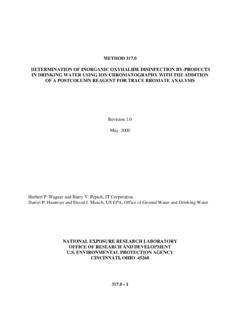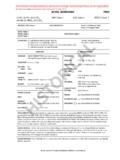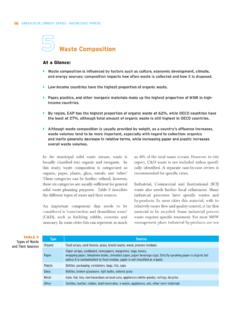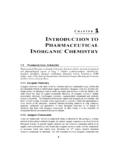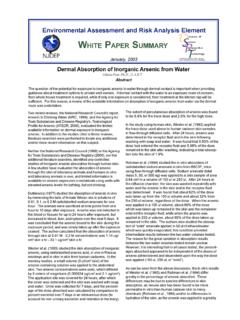Transcription of COBALT AND INORGANIC COBALT COMPOUNDS
1 This report contains the collective views of an international group of experts and does not necessarily represent the decisions or the stated policy of the United Nations Environment Programme, the International Labour Organization, or the World Health Organization. Concise International Chemical Assessment Document 69 COBALT AND INORGANIC COBALT COMPOUNDS First draft prepared by Dr James H. Kim and Dr Herman J. Gibb, Sciences International Inc., Alexandria, Virginia, USA; and Mr Paul D. Howe, Centre for Ecology and Hydrology, Monks Wood, Huntingdon, Cambridgeshire, United Kingdom Published under the joint sponsorship of the United Nations Environment Programme, the International Labour Organization, and the World Health Organization, and produced within the framework of the Inter-Organization Programme for the Sound Management of Chemicals.
2 The International Programme on Chemical Safety (IPCS), established in 1980, is a joint venture of the United Nations Environment Programme (UNEP), the International Labour Organization (ILO), and the World Health Organization (WHO). The overall objectives of the IPCS are to establish the scientific basis for assessment of the risk to human health and the environment from exposure to chemicals, through interna-tional peer review processes, as a prerequisite for the promotion of chemical safety, and to provide technical assistance in strengthening national capacities for the sound management of chemicals.
3 The Inter-Organization Programme for the Sound Management of Chemicals (IOMC) was established in 1995 by UNEP, ILO, the Food and Agriculture Organization of the United Nations, WHO, the United Nations Industrial Development Organization, the United Nations Institute for Training and Research, and the Organisation for Economic Co-operation and Development (Participating Organizations), following recommendations made by the 1992 UN Conference on Environment and Development to streng-then cooperation and increase coordination in the field of chemical safety.
4 The purpose of the IOMC is to promote coordination of the policies and activities pursued by the Participating Organizations, jointly or separately, to achieve the sound management of chemicals in relation to human health and the environment. WHO Library Cataloguing-in-Publication Data Kim, James H. COBALT and INORGANIC COBALT COMPOUNDS / prepared by James H. Kim, Herman J. Gibb, Paul D. Howe. (Concise international chemical assessment document ; 69) - adverse effects. - toxicity. exposure.
5 Assessment. , Herman J. , Paul D. Health Organization. Programme on Chemical Safety. ISBN 92 4 153069 3 (NLM classification: QV 290) ISBN 978 92 4 153069 9 World Health Organization 2006 All rights reserved. Publications of the World Health Organization can be obtained from WHO Press, World Health Organization, 20 Avenue Appia, 1211 Geneva 27, Switzerland (tel: +41 22 791 3264; fax: +41 22 791 4857; email: Requests for permission to reproduce or translate WHO publications whether for sale or for noncommercial distribution should be addressed to WHO Press, at the above address (fax: +41 22 791 4806.))
6 Email: The designations employed and the presentation of the material in this publication do not imply the expression of any opinion whatsoever on the part of the World Health Organization concerning the legal status of any country, territory, city or area or of its authorities, or concerning the delimitation of its frontiers or boundaries. Dotted lines on maps represent approximate border lines for which there may not yet be full agreement. The mention of specific companies or of certain manufacturers products does not imply that they are endorsed or recommended by the World Health Organization in preference to others of a similar nature that are not mentioned.
7 Errors and omissions excepted, the names of proprietary products are distinguished by initial capital letters. All reasonable precautions have been taken by WHO to verify the information contained in this publication. However, the published material is being distributed without warranty of any kind, either express or implied. The responsibility for the interpretation and use of the material lies with the reader. In no event shall the World Health Organization be liable for damages arising from its use.
8 Risk assessment activities of the International Programme on Chemical Safety, including the production of Concise International Chemical Assessment Documents, are supported financially by the Department of Health and Department for Environment, Food & Rural Affairs, UK, Environmental Protection Agency, Food and Drug Administration, and National Institute of Environmental Health Sciences, USA, European Commission, German Federal Ministry of Environment, Nature Conservation and Nuclear Safety, Health Canada, Japanese Ministry of Health, Labour and Welfare, and Swiss Agency for Environment, Forests and Landscape.
9 Technically and linguistically edited by Marla Sheffer, Ottawa, Canada, and printed by Wissenchaftliche Verlagsgesellschaft mbH, Stuttgart, Germany iii TABLE OF CONTENTS 1. EXECUTIVE SUMMARY ..4 2. IDENTITY AND PHYSICAL/CHEMICAL PROPERTIES ..6 3. ANALYTICAL METHODS ..6 4. SOURCES OF HUMAN AND ENVIRONMENTAL EXPOSURE ..7 5. ENVIRONMENTAL TRANSPORT, DISTRIBUTION, AND TRANSFORMATION ..9 6. ENVIRONMENTAL LEVELS AND HUMAN Environmental levels ..11 Human exposure.
10 12 7. COMPARATIVE KINETICS AND METABOLISM IN LABORATORY ANIMALS AND Absorption ..13 Distribution ..14 Elimination ..14 Pharmacokinetic models ..15 Biological monitoring ..16 8. EFFECTS ON LABORATORY MAMMALS AND IN VITRO TEST SYSTEMS ..16 Single Short-term Medium-term Long-term exposure and Genotoxicity and related end-points ..19 Reproductive Effects on Developmental toxicity.











